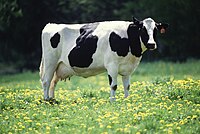
Photo from wikipedia
Bacillus cereus not only has adverse effects on the nutrition and shelf life of dairy products but also seriously endanger people’s health. This study was conducted to reveal the prevalence… Click to show full abstract
Bacillus cereus not only has adverse effects on the nutrition and shelf life of dairy products but also seriously endanger people’s health. This study was conducted to reveal the prevalence and genetic diversity of B. cereus strains isolated from raw milk and cattle farm environments. A total 56 of B. cereus strains were detected from 300 environmental samples (soil, water, fodder, air, milk pails, milking machines, cowsheds, bedding, excrement, cow surfaces, udders, overalls, soles, and staff hand samples) and 50 raw milk samples, and divided into 18 sequence types (STs) using multilocus sequence typing method. These STs included ST27, ST61, ST92, ST142, ST168, ST208, ST378, ST427, ST766, ST 857, ST1098, ST1140, ST1194, ST1236, ST1336, ST1339, ST1341, and ST1348, among them, ST857 (7/56, 12.5%) was the dominant ST, and were detected from air, cowsheds, bedding, excrement, and raw milk samples. Our findings could reveal the distribution and genetic diversity of B. cereus strains in raw milk and cattle farm environments, and provide a theoretical basis for controlling the potential harm of this pathogenic bacteria in dairy products.
Journal Title: Current Microbiology
Year Published: 2019
Link to full text (if available)
Share on Social Media: Sign Up to like & get
recommendations!